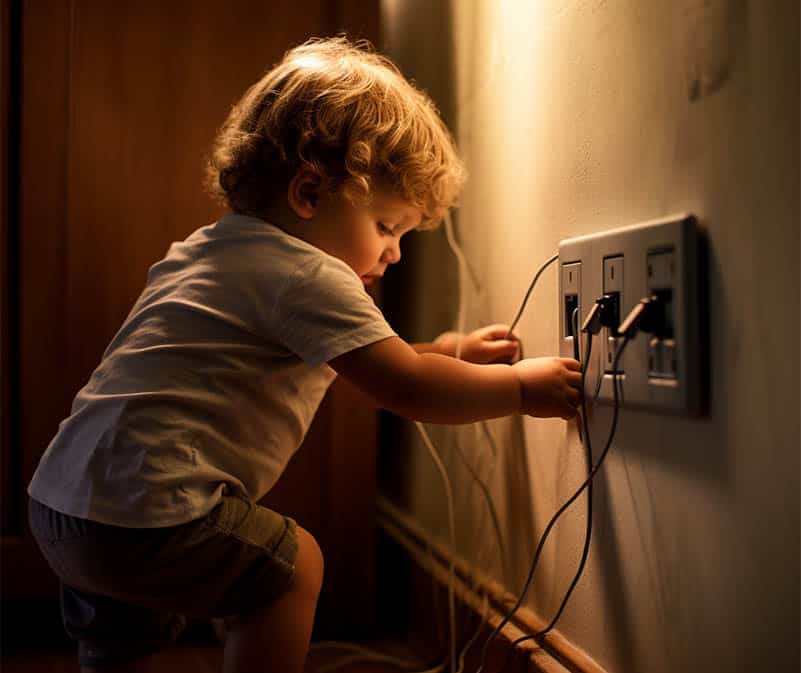GFCIs: A Leap Forward in Home Electrical Safety

But the simplicity of GFCIs hides their challenges for DIYers
Even if you aren’t an avid DIYer, you likely have heard the words GFIs or GFCIs when you purchased your home.
Both terms, Ground Fault Circuit Interrupter and Ground Fault Interrupter refer to the same electrical safety device. The device protects against electrical shock by interrupting the flow of electricity when a ground fault is detected.
Because of their life-saving function, GFI/GFCIs have found their place in many areas of our homes. But even though their main application is based on fairly simple principles, they remain a technically advanced product. Their installation in a home is a job for a professional electrician who knows code compliance requirements.
In this article, we will dive a little bit deeper in the history and function of these devices. We also describe 12 common errors DIYers make when installing them.
GFCIs: how do they work?
As mentioned, a GFCI protects against electrical shock “by interrupting the flow of electricity when a ground fault is detected”. When does ground fault occur? When electrical current escapes the intended circuit and flows to the ground, posing a risk of electrical shock or fire.
For instance, Bubba drills a hole in a bathroom wall and nicks a copper water pipe. Water starts leaking along a drywall and over the backside of electrical outlets. Electricity follows the path of water and the circuit is now escaping its intended route. It flows with the water to the ground. Shock!
The GFCI monitors the imbalance between the current flowing into the “hot” wire and the current returning through the “neutral” wire. When the imbalance exceeds a preset value (typically 4-6 milliamperes) the GFCI/GFI trips and cuts off the electrical supply to the circuit within milliseconds.
Better for your health, no? That’s how they work.
Pre-GFCI Era: standard outlets and fuse boxes
The first question that comes to mind, naturally, is how people lived without them?
Well, the facetious answer is that they did not live long if they faced that type of accident.
Seriously, the old Victorian buildings in London were extremely vulnerable to the risk of electrical fires, for multiple reasons. One of these was the “Knob-and-Tube Wiring”, which lacked a ground wire. This type of wiring increased the risk of overheating and fires. These apartments did not use circuit breakers either. They had fuse boxes. These are less sensitive to current fluctuations — and therefore less effective at preventing electrical fires.
Closer to today, before the advent of GFCIs, homes had standard outlets everywhere, including bathrooms and kitchens. These offered no special protection against ground faults. Electrical safety largely depended on fuse boxes interrupting a circuit in case of an overload or short-circuit. But they were not sensitive enough to detect small current leakages that could cause electrical shocks or fires.
Our great-grand parents were living in death traps.
Not just homes, but also factories and workshops. The founder of Lego, for instance, saw his wood workshop burned to the ground twice! Bad electrical circuitry and wood… never a good marriage.
Early attempts: isolation transformers and ELCBs
Necessity is the mother of invention. Industrialists searched actively for safer solutions that would avoid burning their buildings, tools, and… workers.
Isolation transformers
In the mid-20th century, factories started using isolation transformers. Their primary purpose was to isolate the equipment from the main electrical supply. They became particularly important in applications using sensitive electronic equipment or where the electrical environment was hazardous: like chemical plants and laboratories dealing with flammable materials.
Transformers provided a way to mitigate the risks associated with electrical faults by ensuring that any fault condition in the connected equipment did not propagate back to the main electrical supply.
Earth Leakage Circuit Breakers (ELCBs)
Engineers designed these devices to detect current leakages to the ground. However, they had limitations, such as not detecting imbalances between the hot and neutral wires.
Around this time, burgeoning electrical safety standards and guidelines found their way into law books.
Dalziel and the development of GFCIs
The Ground Fault Circuit Interrupter addressed all these limitations.
Charles Dalziel, a professor in electrical engineering at the University of California Berkeley, conducted extensive research in the 1940-50s. He established the levels of electrical current that the human body can tolerate without suffering severe injury or death.
These studies involved both animal testing and voluntary human subjects to understand the physiological responses to electrical currents. He quantified the “let-go” current: the maximum current at which a person can release their grip from an electrified object. He also studied the thresholds for pain, muscular contractions, and ventricular fibrillation (a life-threatening heart rhythm disturbance).
Dalziel used a range of electrical currents, frequencies, and durations to study their effects. He also took into account variables like skin resistance, which can affect the severity of an electrical shock. History does not tell what happened to his subjects. However, Dalziel did not die on the electric chair, so we can safely assumed he killed no one.
His research provided valuable data on the levels of electrical current that could cause various physiological effects, ranging from mild discomfort to severe injury or death, and it also served as a basis to set the parameters for the operation of GFCIs, such as the trip levels and response time.
First commercial models of GFCIs
Square D, an electrical equipment company, launched the first commercially available GFCI on the market in 1968. Charles Dalziel had nothing to do with the commercial product.
Unlike its predecessors of the first half of the 20th century, the GFCI can quickly detect even minor imbalances between the hot and neutral currents, indicative of a ground fault, and interrupt the circuit within milliseconds.
That was a revolution in electrical engineering. It was a leap forward of safety standards in the construction industry and across the American industrial landscape.
Wider adoption
However, it wasn’t until the 1971 edition of the NEC (National Electrical Code) that the installation of GFCIs became mandatory for certain high-risk areas. Initially, the regulator limited the requirement to outdoor receptacles and certain interior locations, such as construction sites.
Over the years, the NEC expanded the list of locations requiring GFCIs, with their use gradually gaining ground into our homes. GFCIs became mandatory for bathroom receptacles in 1975. The requirements have since extended.
Article 210.8 of the 2020 edition of the NEC requires GFCI for all 125-volt through 250-volt receptacles installed in:
- Bathrooms
- Garages and accessory buildings
- Outdoors
- Crawl spaces
- Unfinished basements
- Kitchens: countertops and within 6 feet of a sink
- Laundry areas
- Boathouses
- Indoor damp and wet locations
- Sinks: Where receptacles are installed within 6 feet of the top inside edge of the bowl
Article 680 of the NEC also requires GFCI protection for equipment like pool pumps and spa tubs.
These requirements are based on statistical data and studies that identified these areas as high-risk for ground faults.
GFCI: A Technical Product
Despite their apparent simplicity, GFCIs remain technical products. By this, we mean that installing a GFCI is not an amateur’s business.
City electrical inspection enforce compliance with NEC guidelines. Failure to install GFCI protection where and as required by the NEC is a violation of electrical codes. This typically result in penalties or required remediation.
12 common errors in installing GFCIs/GFIs
In our experience as electrical contractors, DIYers are likely to make errors and code violations when they install GFCI themselves. Here are 12 types of issues we met.
Incorrect wiring
How it could happen: It is easy to confuse the LINE and LOAD terminals on the GFCI receptacle. The LINE terminals receive the incoming power supply. The LOAD terminals are for extending GFCI protection to other standard outlets downstream.
Example: We have seen the incoming hot and neutral wires connected to the LOAD terminals instead of the LINE terminals. The GFCIs could not function as intended: the test button did not work, and the circuit apparently protected was not.
Failure to test
How it could happen: People install a GFCI and forget to use the built-in test button or a tester to confirm its functionality.
Example: Let’s say you installed a GFCI in your bathroom and restored power without pressing the test button. The device appears to work because it supplies power, but in fact it may not trip when a ground fault occurs.
Improper grounding
How it could happen: (1) The DIY installer fails to attach the ground wire securely to the ground terminal, or (2) omits the ground wire altogether.
Example: If you are installing a GFCI in an older home with two-wire systems (no ground) and you neglect to attach a ground wire to the GFCI, the device will still function but will not protect you against electrical shocks.
Daisy-chaining GFCIs
How it could happen: You could install several GFCIs in series on the same circuit, thinking that more protection is better.
Example: In a kitchen, we have seen three GFCIs in a row for three different outlets. When a ground fault occurs at the last outlet, all three GFCIs trip simultaneously. This makes it difficult to identify the source of the fault. Where is the cause?
Wrong circuit
How it could happen: This is the case when you install a GFCI on a circuit for which it is not rated, in terms of either amperage or voltage.
Example: We have seen GFCIs rated 15-amp installed on a 20-amp circuit. The device can’t handle the higher current effectively. The result usually is premature failure or the GFCI can’t trip during a ground fault.
GFCIs need weather-resistant covers
How it could happen: Homeowners installed the GFCI receptacle outdoor with a standard wall plate… It’s a code violation because you need to use a weather-resistant cover.
Why is it a violation? When people use a standard indoor wall plate on an outdoor receptacle (instead of a weather-resistant cover), moisture infiltrates the receptacle over time, and compromises its ability to detect ground faults.
Incorrectly locating a GFCI
How it could happen: If you don’t know the NEC guidelines, you will install GFCIs in locations where they are not required and omit to install them where they are mandatory.
Example: We’ve seen people installing a GFCI in their living room, thinking it would adds extra safety to their electrical installation. But they forgot to add one near their kitchen sink. The NEC makes it mandatory to install GFCIs in areas with water sources. Code violation.
Use of standard receptacles in GFCI-required areas
How it could happen: When people want to pinch a penny, they often use the wrong tool for the wrong purpose. Like replacing a faulty GFCI with a standard receptacle.
Non tamper-resistant GFCI receptacles
How it could happen: The NEC requires tamper-resistant receptacles but people don’t know it, so they install non-tamper-resistant GFCI receptacles in their home. If you have young children, that’s a serious problem.
Arc-Fault Circuit Interrupter (AFCI) conflicts
How it could happen: Where you need to have both GFCI and AFCI protections, you create a conflict between the two safety mechanisms if you do your wiring incorrectly or select the wrong device.
Example: In a bedroom requiring both GFCI and AFCI protection, you install your GFCI receptacle downstream of the AFCI breaker. The two devices trip each other due to incompatible technologies. This will cause frequent circuit interruptions.
Forgetting to label your GFCIs
How it could happen: After installing a GFCI, if you don’t label the receptacle or the circuit breaker to indicate GFCI protection, you are in violation of NEC requirements.
Example: Let’s say you install a GFCI to protect multiple outlets in your garage. But you forget to label the GFCI-protected outlets or the corresponding circuit breaker. Will future users and electricians be aware that the circuit has GFCI protection?
Improperly spacing GFCIs
How it could happen: If you don’t know the NEC spacing requirements, you could install a GFCI too close or too far from fixtures (sinks) or water sources.
Example: We have seen a GFCI installed 8 feet away from a kitchen sink. The NEC mandates GFCI protection for any receptacle installed within 6 feet from the top inside edge of the bowl of a sink. This installation does not comply with NEC guidelines.
Installing GFCIs in your home: a job best left to a licensed electrical contractor
In business for 30 years as a licensed electrical contractor in San Antonio, we have seen all kinds of code violations and dangerous installations.
One of the most dangerous situations which DIY lovers can create and expose their children to is to believe they are protected… when in fact, unbeknownst to them, they just messed up and have a serious electrical hazard on their hands.
GFCIs are marvelous devices. This is why the regulators mandated them for many applications in every home. But they are not that simple to install in compliance with code. We can’t recommend you to tackle this task yourself.
By calling a licenced electrician like All Star Electric you achieve 2 results:
- A safe, reliable GFCI installation,
- An opportunity to get an inspection of your entire electrical installation for safety and code compliance.
The well-being of your family certainly deserves that call. Schedule an appointment at (210) 391-0274.
Additional resources
All Star Electric offers the reliability of an A+ rating at the San Antonio BBB.
All Star Electric also has a 4.8 rating on Google.
More on our GFCI installation services
FAQ
A GFCI is an electrical safety device that protects against electrical shock by interrupting the flow of electricity within milliseconds when detecting a ground fault.
The 2020 edition of the NEC requires GFCIs in bathrooms, garages, outdoors, crawl spaces, unfinished basements, kitchens, laundry areas, boathouses, indoor damp and wet locations, as well as near sinks and for equipment like pool pumps and spa tubs.
Common errors include incorrect wiring, failure to test the device after installation, improper grounding, daisy-chaining multiple GFCIs, and installing GFCIs on circuits for which they are not rated.
Failure to install GFCI protection where and as required by the NEC is a violation of electrical codes and typically results in penalties or required remediation.




























